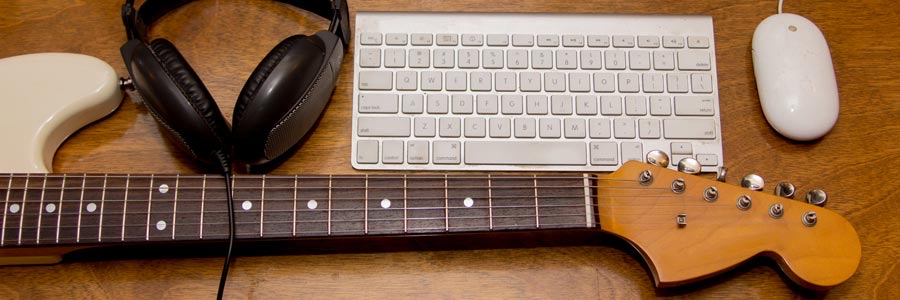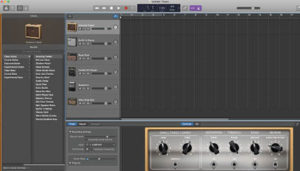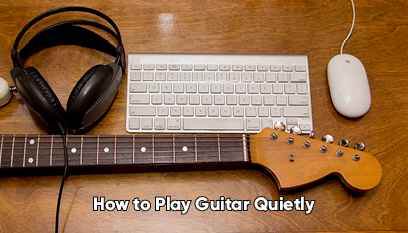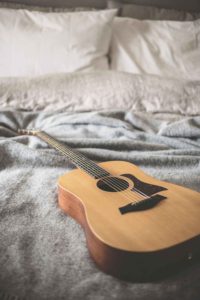
In most situations where you need to play electric guitar quietly, even a low-watt amp is just too loud. You’re better off either playing unplugged or using headphones with your amp or a program like GarageBand.
Part of the fun of electric guitar is playing as loudly as possible. But what if you need to play quietly, so you don’t disturb other people in your house or dorm? Whether you’re playing late at night or just dealing with paper-thin apartment walls, there are ways to practice at a lower volume.
First of all, it’s helpful to consider why you are practicing. Are you just getting started with playing guitar — or returning to the guitar after a break — and need to build up muscle strength and calluses? Or are you a more experienced guitarist looking to improve your playing and nail your parts?
Beginners and Returners
Let’s start with the beginners or the returning players, who are working on building up calluses and practicing chord changes. In that case, volume is irrelevant — in fact, you may prefer to be quiet because you don’t want anyone to hear your work in progress. I get it. This is how I feel every time I come back to the guitar after an extended absence.
If you’re in this boat, my advice is to bring your unplugged electric somewhere with nothing else (except maybe a tuner which you can read my opinions on here ) and just start playing. The sound of the un-amplified strings will be enough to let you know if you’re on the right track, and you’ll be building up calluses and muscle strength as you go. I do this all the time while watching music documentaries my recliner, because I get fidgety just watching TV.
“The Silent Piano”
My great-grandfather, Pasquale Tallarico, was a concert pianist. He won a prestigious piano competition in the early 1900s, and spent the rest of his life performing and teaching.
Later in life, he maintained a summer residence in rural southern New Hampshire, where I grew up. As family legend has it, he used to practice on his “silent piano” from time to time. This piano no longer had the hammers making contact with the strings, but he still knew exactly what his playing would sound like.
Students from as far away as Boston would come to the woods to study with the great musician. Sometimes, halfway through the lesson, he would wander off and start tending to the garden. Curious, but not sure what to do, the students would crane their necks and back away from the keys (while still playing) to see where he had gone. As they got frustrated they would inevitably start taking shortcuts with their playing… Until he would shout from the garden, “You played that note with the wrong finger!”
Where was I going with that little story? Don’t think you’re too good to practice without amps or effects. If you need to practice but you have to be quiet, there’s still plenty to be gained from the “silent piano.”
What If You Really Don’t Want to Play Unplugged?
For many more experienced players, manipulating the sound is a big reason why they love playing guitar. Playing unplugged just isn’t much fun. Fair enough! So let’s talk tech.
Get Some Decent Headphones
This is not a time for earbuds. Earbuds blast sound straight at your eardrum from an advanced position within your ear canal and can do serious damage very easily. Many people also find that earbuds get very uncomfortable in a short amount of time.
Get yourself a decent set of over-the-ear headphones. You don’t need the latest and greatest noise cancelers for this, just a pair of real headphones that are comfortable to wear.
Some lines of amps, especially practice amps, have headphone jacks built in. What you hear through the headphones sounds more true to your amp’s tone, but you may lose the ability to play along with recorded music as part of your practice routine.
Just be mindful of the headphone cord while you’re playing, since accidentally pulling out the jack could scare the crap out of your family.
If You’re a Mac User, Try GarageBand

Mac users have a secret weapon: GarageBand.
Even 10 years ago, I thought GarageBand was too good to be given away for free with the operating system. Back then, once you ganged in the GuitarRig plug-in you felt like you had the world of tone at your fingertips, and you more or less did. At least one of the players I will be featuring on this blog actually fooled some seasoned studio pros into thinking that one of his albums featured all live guitars when in fact it was GuitarRig all the way.
So if you’re a Mac user, fire up your computer, plug in your guitar and your headphones, and rock out as hard as you want.
Amp Considerations
If you often need to play quietly and you’re in a position to consider buying a new amp, I suggest you make the ability to sound good at “bedroom volume” a top priority. That is one of the reasons I went with my Vox AC-15. It’s an amp that even at full bore won’t take your head off, but at low volume will still remind you that it comes from a classic lineage. (If you were hoping to use headphones but your current amp does not have a headphone jack, that could be another consideration for your shopping list.)
After amp selection, focus on amp placement. For a variety of reasons, guitar amps should not be left on the floor. Get yourself an amp stand, or at least rig up something that gets your amp off the floor and points the speaker toward yourself. This will send the sound waves straight to you and eliminate the noise pollution you’d create through the amp’s direct contact with floors and walls.
Playing Acoustic Guitar Quietly
There are many situations in which electric guitar and acoustic guitar can be, and should be, approached as different instruments. Most of this post has been focused on electric guitars, but acoustic players also have options for reducing volume.
If you regularly play your acoustic as an acoustic/electric, chances are you’ve invested in a Feedback Buster (Amazon link). If you haven’t yet, do it! The same device that helps you dampen the resonators from your acoustic to prevent feedback can help you control volume.
Ultimately, though, with an acoustic guitar YOU, the player, are responsible for the volume. Need it quieter? Don’t play so hard! You can also try thinner strings, thinner picks, and palm-muting to make your playing a little softer. Some people cram a T-shirt or a towel in the soundhole to muffle the sound, with mixed results.
Back To Basics
A few months back I watched a great tutorial by Christian McBride called “Your Sound Is Your Signature.” Granted, that video is geared towards upright bass players, but I was very much taken in by some of his tips.
Too summarize (poorly), McBride encourages players to practice without an amp and to focus on the tone they create with their instruments and their hands.
Regardless of the instrument, it’s a message worth meditating on. I certainly think my great-grandfather, Pasquale, would approve.


